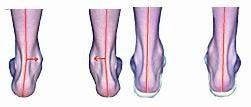The medical term is "pronating" or even "overpronating". This is when your heels/ankles have a tendency to invert towards the inside so that your arch of the foot becomes flat. For people who have this tendency, the Rebounder acts like a magnifying glass and makes this habit visible. It is not the Rebounder that makes you pronate, rather you pronate and the Rebounder makes you aware of it. And the softer the surface of the Rebounder, the easier you can see it. About 65% of all people have a tendency to pronate and often you have it more developed on one foot than on the other.
There are also people who do the contrary. This is called "supinating". Supinating is when the ankles are falling towards the outside. Then most of the person's weight is resting on the outside of the feet and you can see this when you look at their shoes. The soles on the outside are much more used then on the inside. About 15% of people are supinating.
 left side: pronating right side: correct position
left side: pronating right side: correct position
How to Stop Pronating / Supinating
Now, what can you do when you discover you are pronating or supinating? If this tendency is very developed, you might have noticed this already and possibly saw a physiotherapist or a foot specialist. If you do not have any problems or pain but you are pronating or supinating, you still might want to correct this habit before starting to Rebound.
The trick to stop pronating or supinating is to control your heel. You want to position your foot in a way that your heel is in a 90 degree angle to the floor. Train this on the floor. And later train this on an unstable surface like a Rebounder. Your body will be happy if you correct this habit. Many people's knee problems disappear just by correcting their feet position.
left side: pronating right side: correct position


